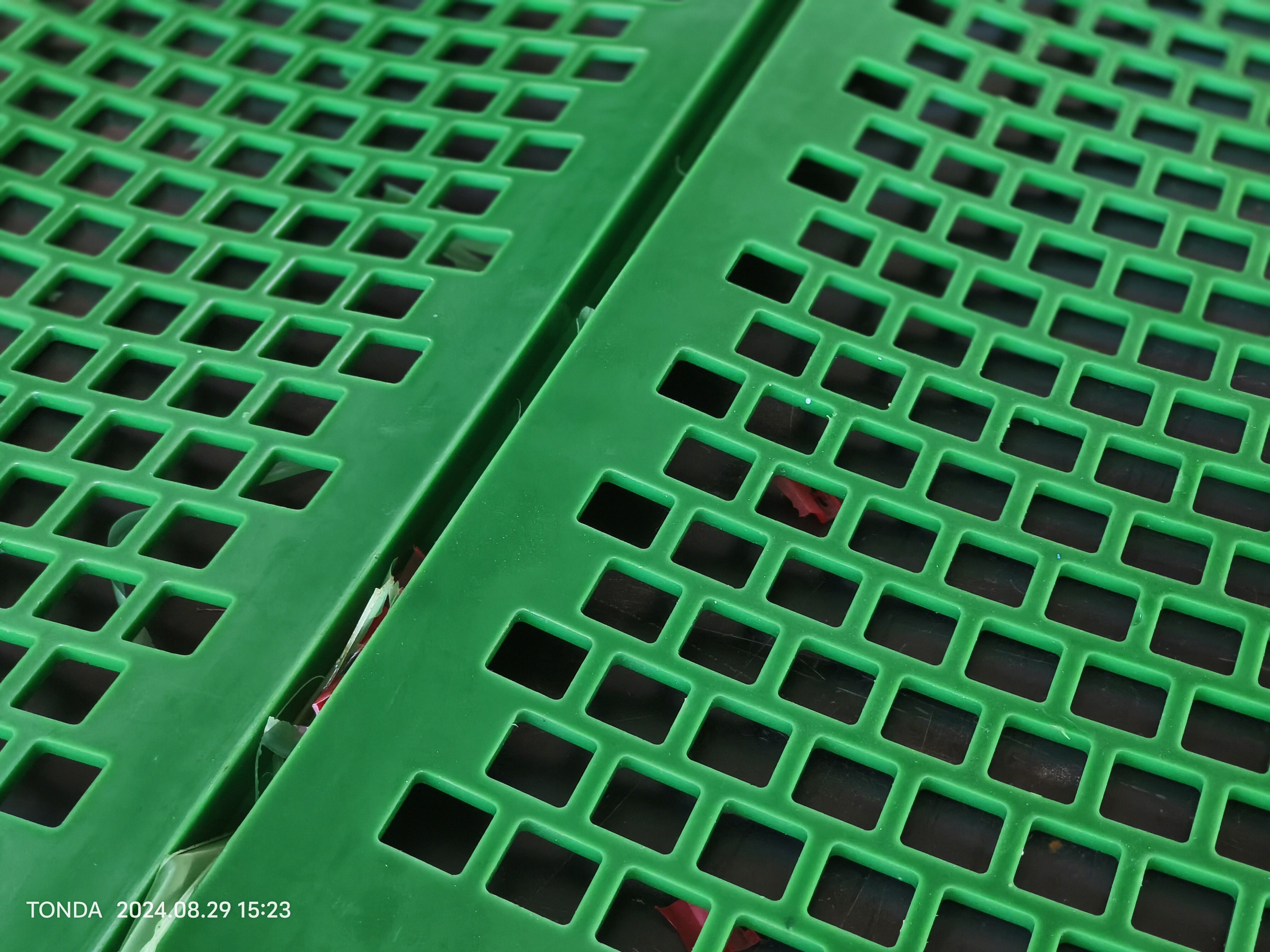Understanding Polyurethane Relaxation Screen Mechanics
Core Components of Vibratory Screening Systems
Vibratory screening systems play a big part in separating different materials during processing operations. These systems typically include several main parts like drive motors, screen frames, and those tough polyurethane screens we all know and love. Every component contributes something important to how well the whole thing works. Drive motors generate the vibrations needed to move stuff along the screen surface so particles get sorted properly. Screen frames hold everything together and need to be strong enough for continuous operation day after day. And let's not forget about those polyurethane screens themselves which last longer than other options and bend just right without breaking down under stress. Looking at real world applications, companies have found that when they invest in good quality vibratory screening equipment, they often see noticeable improvements in how much material gets processed each hour, which translates directly into better overall production numbers for their business.
Role of Linear Vibrating Screens in Material Separation
Linear vibrating screens play a big role in separating materials based on size and density thanks to their straight line movement from the way they're built. The back and forth action helps sort stuff better because it keeps material moving smoothly over the screen surface. What makes these screens stand out? They can tweak both angle and vibration speed, so operators get better control over how materials flow through the system while reducing stoppages. Factories that have switched to them report noticeable improvements too. Some manufacturing plants saw around 20 percent boost in how well they separate different sized particles when they started using linear vibrating screens instead of older models.
Elasticity Dynamics in Polyurethane Mesh Design
How stretchy polyurethane mesh is plays a big role in how well it handles impacts without losing shape when put to work. These materials combine bendiness with toughness, which explains why they're so popular for screening applications that deal with constant shaking and serious weight loads day after day. Modern mesh constructions actually build in certain stretch characteristics specifically to keep materials from slipping through gaps and reduce wear over time. Some studies have found that getting the right balance of give and take in these meshes can make them last around 30 percent longer than standard options on the market today. That kind of longevity really matters for operations looking to cut down on replacement costs and downtime in the long run.
Abrasion Resistance in High-Moisture Environments
Polyurethane relaxation screens stand out because they resist abrasion so well compared to regular steel mesh, especially when moisture is involved. These screens keep working properly even when exposed to tough environments, which makes them really useful in places like mines and quarries where everything gets pretty rough on equipment. The fact that they don't wear down as fast means operations stay efficient without constant replacements. Tests show these polyurethane screens actually last about 40% longer in wet conditions than metal ones do. That kind of longevity represents a big leap forward for screening tech, saving both time and money in the long run for companies dealing with harsh materials day after day.
3-8x Lifespan Compared to Metal Mesh Screens
One major benefit of polyurethane screens stands out right away their much longer life span compared to regular metal mesh screens. We're talking about lasting anywhere between three to eight times longer in most cases. Why does this happen? Well, polyurethane just bends better and takes abuse without breaking down as quickly as metal does. This means fewer broken screens lying around waiting to be replaced. For factories running 24/7 operations, this makes all the difference. Less time spent swapping out worn screens equals more uptime on production lines. Industry numbers back this up too many businesses report cutting their maintenance bills by almost half after switching from metal to polyurethane screens. That kind of savings adds up fast across an entire facility.
Reduced Clogging Rates Through Material Flexibility
Polyurethane screens have a real advantage when it comes to reducing clogging problems, which makes them great for handling all sorts of different materials. Their ability to adjust means better drainage and smoother flow throughout the system something that really matters when running screening operations. These flexible screens actually bend and shape themselves around whatever material is passing through, so operations don't get interrupted as often. Looking at actual field reports, companies using polyurethane instead of standard rigid screens saw anywhere from 25% down to even higher reductions in those annoying clogging issues. That kind of performance difference explains why so many plants switch to these screens especially when dealing with tricky materials that change characteristics during processing.
Optimizing Wet Material Screening Efficiency
Fluid Dynamics in Slurry Processing Applications
Getting a good grasp on how fluids behave matters a lot when it comes to making slurry processing work better, since what happens with these materials really affects how well they separate out. When we put polyurethane screens into the mix, they help manage how materials move around by cutting down on all that chaotic swirling motion that messes up the screening process. Industry folks who've looked at this stuff report that tweaking fluid dynamics can boost screening performance somewhere around 30 percent in certain slurry situations, which means cleaner results and faster processing times. What's great about this method is that it cuts down on power usage while getting more bang for our buck from existing equipment. For operations dealing heavily with slurry processing, this kind of improvement makes all the difference in day to day running costs and overall productivity levels.
Anti-Static Properties for Cohesive Materials
The anti static nature of polyurethane screens makes all the difference when working with materials that stick together and form clumps. What this means is better flow control and more effective separation, something that matters a lot in operations processing big volumes where every minute of downtime adds up. Some studies have found that adding these anti static features can boost system reliability around 20 percent. The result? Fewer interruptions during production runs and maintaining those important productivity numbers. Manufacturing plants that handle tons of sticky substances daily will notice significant improvements too, as these screens help clear away blockages faster and keep things moving smoothly through the entire process line.
Modular Panel Replacement Strategies
When it comes to screening processes, going modular with panel strategies makes maintenance work much simpler. Technicians can swap out panels right on site without causing major interruptions to operations. The downtime drops quite a bit this way, and workers find it much easier to tweak things according to what materials they're dealing with at any given time. Looking at actual numbers from companies that have switched to these modular systems, maintenance times drop around 40% on average. That means more productive hours and less money spent on labor costs over time. What really stands out about modular panels is how flexible they are. Industrial facilities facing constantly shifting demands don't need to tear everything apart just to make adjustments. These panels handle changes in production needs pretty well, keeping operations running smoothly even in tough manufacturing environments where every minute counts.
Technical Innovations in Polyurethane Screen Design
Dual-Layer Tensile Reinforcement Systems
New tech innovations have made it possible to create dual layer tensile reinforcement systems that really boost how long polyurethane screens last. The way these systems work is pretty clever actually they spread out the tension evenly across the entire screen surface. This means there's less chance of the screen giving way when things get rough during operation. For industries operating in tough conditions where equipment gets pushed to its limits, this kind of reinforcement makes all the difference. We've seen real world testing show breakage rates drop dramatically when companies switch to these dual layer setups. Manufacturers report fewer replacements needed over time. What makes these systems stand out is their ability to hold up under extreme pressure situations common in heavy duty manufacturing environments.
Acid/Alkali Resistant Polymer Formulations
New polymer blends that stand up to corrosive materials are making a real difference in how long screens last in tough settings such as chemical plants. The latest materials handle extreme stress without losing their ability to separate different substances effectively. For facilities dealing with acids and bases all day long, this kind of durability matters a lot since traditional materials would break down quickly under those conditions. Chemical companies report seeing screen lifespans go up by around twice what they were before when switching to these resistant formulations. Beyond keeping operations running smoothly, longer lasting screens mean fewer replacements needed and less time spent fixing or replacing damaged equipment during production.
Precision Perforation Patterns for Grading Control
Getting the right perforation pattern matters a lot for controlling how materials get graded, which leads to better quality separations across different industrial applications. New technologies in perforation mean we can actually create custom patterns suited specifically for what each application requires, and this helps boost productivity quite a bit. When companies tailor these patterns to their particular needs, they see much better results in terms of grading accuracy something that really matters in sectors where getting the right material size is absolutely essential. Looking at real world data from all sorts of grading operations shows around a 20% improvement in accuracy when working with precision perforated screens instead of old fashioned methods. All this points to why investing in precise perforation makes such a difference in making material separation both more efficient and effective overall.
Operational Best Practices & Maintenance
Blind Spot Reduction Through Dynamic Vibration
Adding dynamic vibration methods to screening processes really cuts down on those annoying blind spots while making materials move through the system much better. When we install these advanced vibration controls, operators get to keep a close eye on things and make necessary tweaks along the way, which helps maintain good product consistency throughout. According to industry experts, fixing those problem areas where nothing gets screened properly could actually improve the whole operation's effectiveness somewhere around 25%. The bottom line is that this kind of efficiency boost means higher production rates without wasting so many resources, and let's face it, nobody wants their money going down the drain when there are simpler ways to save costs.
Moisture Content Threshold Management
Getting the right moisture balance matters a lot when it comes to screening processes because wet materials behave differently than dry ones during separation. Moisture sensors help plant operators spot those sweet spots where things work best, so they don't end up wasting time or resources on suboptimal setups. Some studies looking at mining and recycling operations have found around 15 percent better results when moisture levels are properly managed. When plants keep track of how damp their feedstock actually is, they not only get cleaner separations but also extend the life of their screens and other equipment. The savings add up over time as machines break down less frequently and maintenance costs stay lower.
Cost-Benefit Analysis of Preventative Upkeep
Keeping screening equipment well maintained regularly saves companies a lot of money over time because it extends how long machines last before needing replacement and cuts down on those annoying surprise breakdowns during production runs. When businesses actually sit down and compare what they spend on regular upkeep versus what gets lost when operations grind to a halt due to equipment failure, the numbers tell a clear story. Maintenance budgets typically pay for themselves many times over. Some studies show that sticking to proper maintenance routines can slash long term expenses by around 40 percent. The bottom line is simple: equipment stays running smoothly when we take care of it properly, which means fewer expensive emergency fixes and better overall productivity from day one.

